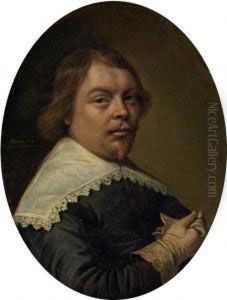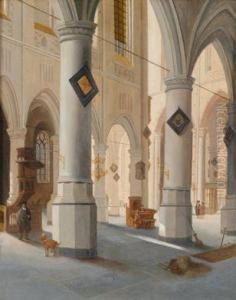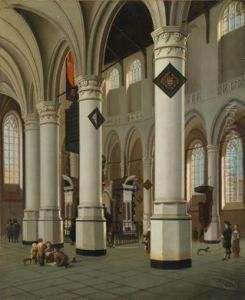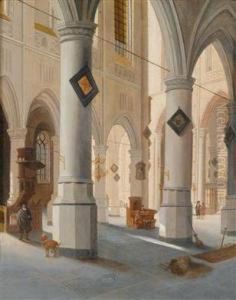Hendrik Van Vliet Paintings
Hendrik Cornelisz van Vliet was a Dutch painter from the Golden Age of Dutch painting, primarily known for his church interiors. He was born in Delft, in the Netherlands, in either 1611 or 1612. Not much is known about his early life, but van Vliet was likely influenced by the artistic environment of Delft and the work of local artists, including the master of light and perspective, Johannes Vermeer, who was active in the same city during this period.
Van Vliet’s works are characterized by their detailed representation of church interiors, particularly the Gothic and Renaissance churches that were prevalent in the Netherlands during his lifetime. He was adept at manipulating perspective and light to create a sense of depth and grandeur within the architectural spaces he depicted. His paintings often included figures, but these were typically subordinate to the grandeur of the architectural setting.
Van Vliet was a pupil of Michiel Jansz. van Mierevelt, a prominent portrait painter of the time, and later became a student of Hendrick Corneliszoon van der Vliet, who was known for his church interiors as well. This tutelage helped van Vliet develop his skills in the sub-genre of architectural painting. He became a member of the Guild of Saint Luke in Delft in 1632, which was an important milestone in his career as an artist.
Throughout his career, Hendrik van Vliet experimented with perspective, and he is noted for his skillful use of vanishing points and his accurate renderings of complex architectural details. His paintings are also remarkable for their use of light, often showing sunlight streaming through windows and illuminating the church interiors in a dramatic fashion.
Van Vliet's contributions to the Dutch Golden Age of painting were significant, particularly in the niche of church interior paintings. His work provides a valuable visual record of Dutch ecclesiastical architecture in the 17th century, as well as insights into the use of light and perspective in art.
Hendrik van Vliet died in 1675 in Delft. His legacy is maintained through his works which continue to be studied and appreciated for their artistic and historical value. Examples of his art are held in the collections of major museums around the world, evidencing the lasting impact of his contributions to Dutch art.



